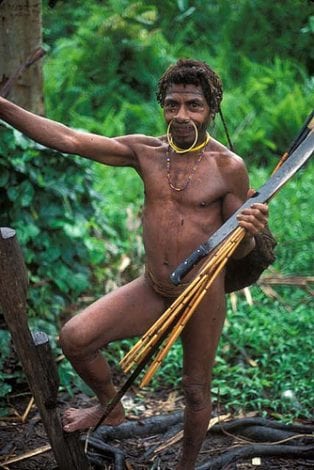A woman in purple sits on a couch cradling a black box. Her name is Casie, inside the box are the remains of her husband Sean, or at least what remains of the remains. To cope with her grief she has been eating his ashes, bit by bit. In two months she has eaten about a pound.

The Korowai people, who live in the remote jungles on the island of Papua New Guinea, may be the last cannibals on earth. If you are deemed to be a khakhua, or secret witch doctor, the tribe just might execute you and eat you, brains first.
“It makes me feel good,” Casie tells a therapist, during an interview for the TLC show, “My Strange Addiction”. “The other part of me is like this isn’t right but the feeling and the gratification of eating overpower the part of me that wants it to stop.” What do they taste like, the therapist wonders. “Rotten eggs, sand, and sandpaper,” says Casie.
Casie’s case is not unprecedented. Neanderthals were thought to be cannibals, and the practice has been documented amongst traditional cultures from the Congo to the Amazon to the South Pacific. Just this past spring in Pakistan a man was arrested for eating dead bodies. A Youtube video shows a gruesome cannibalism crime scene. A slight gaunt body is laid out on the floor, partially covered by a white cloth. The feet have been sawed off and nearby are a pair of pots. Inside are hunks of meat in a yellowish sauce. The narration is in Urdu but we can only assume the pot contains the cooked portions of the man’s feet. Also on the floor are a shovel and a small scraping tool. It seems that the cannibal dug the body from a grave.
Deep in the jungles of southeastern Papua, on the island of Papua New Guinea, live the Korowai people, arguably the last cannibals on earth. Until 1970, the Korowai were unaware that the rest of the world existed. Today there are about 3,000 of them, living amidst tightknit clans in tree houses built upwards of a 100 feet off the ground. If a Korowai tribesman becomes deathly ill unexpectedly a khakhua, or secret witch doctor, is typically held responsible. Khakhuas are nasty things, they assassinate people in their sleep, eating out their guts and replacing them with ash. The sick person may reveal who they think the khakhua to be on their death bed. If the group indeed deems that person to be a khakhua, they will execute them. Supposedly the brain is eaten immediately, while still warm.
The most well-known story of modern day cannibalism is the Miracle in the Andes, the subject of numerous books and films, including the 1993 movie, “Alive”. On October 13, 1973 a Uruguayan charter flight carrying 45 people, including a rugby team and their friends and family crashed high in the Andes Mountains. More than a quarter of the passengers died in the crash and several others died from cold or injury in the days that followed. Eight more were killed in an avalanche. The 16 remaining survivors quickly exhausted their meager supply of food, which consisted of a few chocolate bars, some snacks and several bottles of wine. They used metal from the seats to melt snow in the sun and collected it in the empty wine bottles, but with no food they were starving. The group decided to eat the dead bodies, which had been well preserved by the cold. They began with the pilot.
THE WORLD’S HIGHEST CEMETERY KEEPS GROWING
“We were starving in earnest, with no hope of finding food,” says Nando Parrado, one of the two men who trekked across the Andes for help. He recently wrote a book on the ordeal entitled Miracle in the Andes: 72 Days on the Mountain and My Long Trek Home. “Again and again we scoured the fuselage in search of crumbs and morsels,” says Parrado. “We tried to eat strips of leather torn from pieces of luggage, though we knew that the chemicals they’d been treated with would do us more harm than good. We ripped open seat cushions hoping to find straw, but found only inedible upholstery foam…there was nothing here but aluminum, plastic, ice, and rock.”
The saddest thing about Casie’s story, highlighted on My Strange Addiction, may be that while true cannibals draw sustenance from their corpse meal, Casie gets none. In fact, she may even be poisoning herself. “I’m a little bit concerned about what’s in embalming fluid,” the therapist tells Casie. “Did you know that embalming fluid causes psychosis?”









